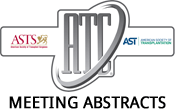2016 American Transplant Congress
Replacing Cold Storage with Normothermic Ex Vivo Kidney Perfusion Improves Function of Grafts Retrieved After Circulatory Death (DCD).
Normothermic ex vivo kidney perfusion (NEVKP) and avoidance of static cold storage (SCS) is an attractive strategy to minimize injury of DCD kidney grafts. We…2016 American Transplant Congress
End Stage Renal Disease (ESRD) Patients' Willingness to Accept Risks to Living Kidney Donors.
Background: While many potential living kidney donors (LKDs) are willing to accept high levels of ESRD risk, receipt of a living donor kidney is also…2016 American Transplant Congress
Imminent Death Donation: Potential Effects on Organ Donation Numbers and Clinical Outcomes.
Attempts at donation after cardiac death (DCD) lead to organ transplantation only among 70% of eligible DCDs. Imminent death donation (IDD) is ante-mortem donation of…2016 American Transplant Congress
Universal Stenting of Renal Transplants Associated with a Low Complication Rate When Quality Assurance Program Ensures Stent Removal.
Urology, University of Missouri, Columbia, MO.
Introduction: The routine use of ureteral stents during renal transplantation remains controversial despite recent evidence that universal stenting decreases ureteric complications. Further, assurance of timely…2016 American Transplant Congress
Evaluation of T Cell Immunity in Elderly Solid Organ Transplant Recipients.
Elderly transplant recipients experience increased rates of death, especially death due to infection, as compared with younger patients. However, little is known about the mechanism…2016 American Transplant Congress
Assessment of mRNA Gene Profiles in Plasma Exosome to Predict Risk for Antibody-Mediated Rejection (ABMR) of Renal Allografts.
Background: ABMR is a major obstacle for successful transplant in HLA-sensitized (HS) patients. Complement-mediated and antibody-dependent cellular cytotoxicity (ADCC) are primarily mechanisms for ABMR. Previously…2016 American Transplant Congress
The Early Outcomes of Bortezomib Therapy in Patients with Late Antibody Mediated Rejection in Renal Transplantation.
Although several strategies for treating antibody mediated rejection (AMR) in renal transplants have been investigated, the formation of donor-specific antibodies (DSA) and ongoing AMR contribute…2016 American Transplant Congress
Analysis of a Large Single-Center Cohort of Renal Transplant Recipients with Histoplasmosis.
Internal Medicine, Vanderbilt University Medical Center, Nashville, TN.
The dimorphic fungus Histoplasma capsulatum is endemic along the Ohio and Mississippi River Valleys and can cause clinically significant disease in those with impaired cellular…2016 American Transplant Congress
Outcomes in Black vs Non-Black Patients Administered Belatacept (Bela) or Cyclosporine (CsA) in BENEFIT.
Studies consistently show worse outcomes for black vs non-black kidney transplant recipients. At 7 yrs post-transplant in BENEFIT, bela was associated with superior graft survival…2016 American Transplant Congress
Unexpected Early Calcineurin Inhibitor Nephrotoxicity in Pediatric Kidney Transplant Recipients.
Background: Calcineurin inhibitors effectively suppress the recipient immune response and facilitate early success in kidney transplantation. However, these drugs are potent nephrotoxins and contribute to…
- « Previous Page
- 1
- …
- 465
- 466
- 467
- 468
- 469
- …
- 531
- Next Page »
